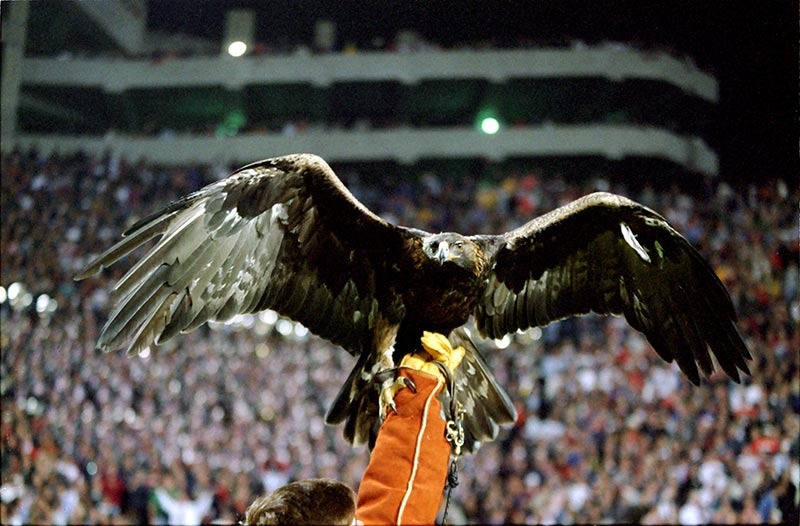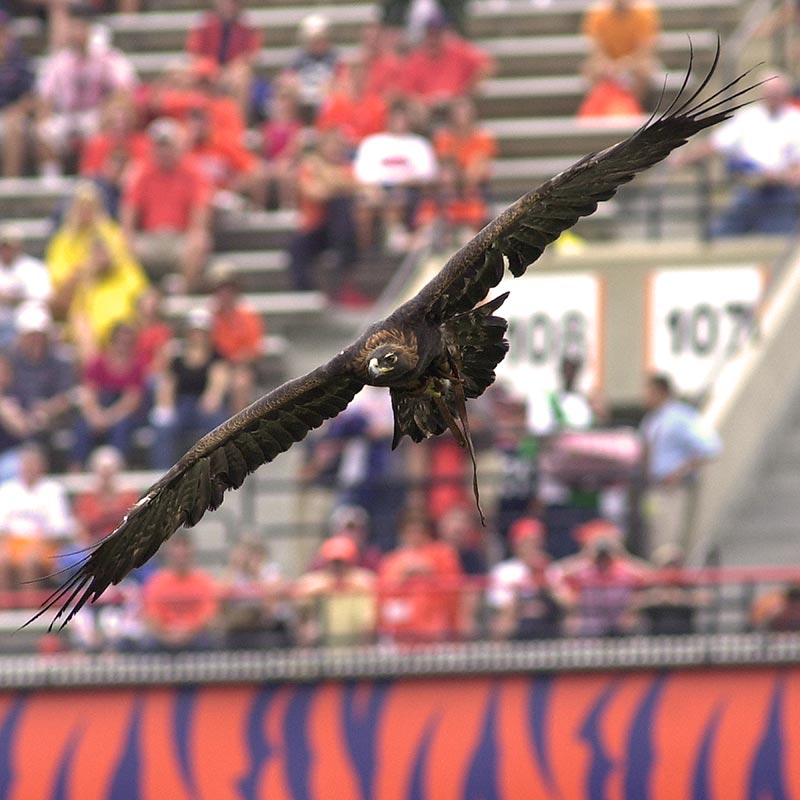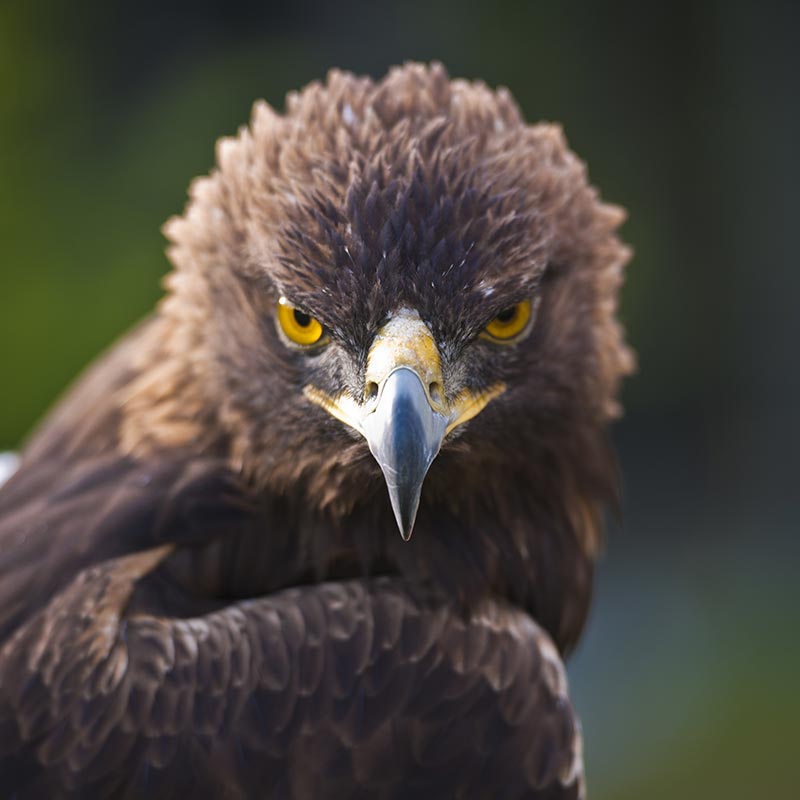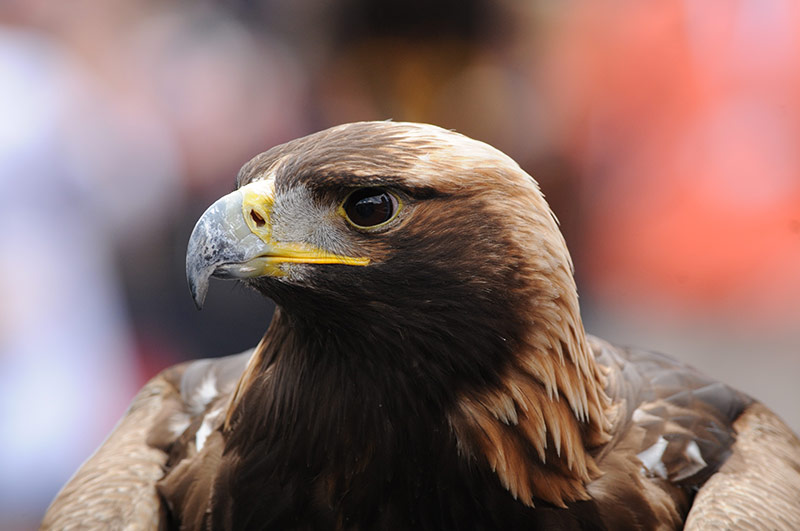War Eagle I (1892)
The mythical War Eagle I has the most colorful story of all of the "War Eagle" eagles. War Eagle I's story begins in the Civil War. According to the legend, a soldier from Alabama during the Battle of the Wilderness came across a wounded young eagle. The eagle was named Anvre, and was cared for and nursed back to health by the soldier. Several years later the soldier, a former Auburn student, returned to college as a faculty member, bringing the eagle with him. For years both were a familiar sight on campus and at events. On the day of Auburn's first football game in 1892 against the University of Georgia, the aged eagle broke away from his master during the game and began to circle the field, exciting the fans. But at the end of the game, with Auburn victorious, the eagle fell to the ground and died.
War Eagle II (1930)

Auburn's first real, live-eagle, War Eagle II, was mentioned in the New York Times, which noted then that "War Eagle" was already established as Auburn's battle cry. In November 1930 a golden eagle swooped down on a flock of turkeys in Bee Hive, Alabama, southwest of Auburn, Alabama, and became entangled in a mass of pea vines. Fourteen individuals and businesses scraped together $10 and purchased the eagle from the farmer who owned the pea patch. Cheerleaders DeWit Stier and Harry "Happy" Davis helped care for the new eagle. It was put in a strong wire enclosure and taken to the Auburn football game against the University of South Carolina in Columbus, Georgia on Thanksgiving Day.
Auburn, having not won a Southern Conference game in four seasons, was anticipated to lose. However, Auburn took a 25-7 victory over the Gamecocks. The student body concluded that the luck from the eagle's presence—which had been absent from their prior losses—was responsible for the victory that day. The eagle was kept in an enclosure behind Alumni Hall (renamed Ingram Hall), and cared for by members of the "A" Club.
The eagle's ultimate fate is unknown. Some say it died or was carried away by students of a rival school. Others say it was given to a zoo due to the high cost of upkeep; there is even a rumor that it was stuffed and put in the John Bell Lovelace Athletic Museum.
Originally known simply as "War Eagle" this eagle was retroactively named "War Eagle II" with the arrival of War Eagle III.
War Eagle III (1960-1964)

Auburn's third eagle arrived in Auburn in November 1960 after being captured by a cotton farmer in Curry Station, Talladega County, Alabama who found the eagle caught between two rows of cotton. The eagle was sent to Auburn by the Talladega County Agent along with a load of turkeys. After a short stay in one of the Wildlife Department's animal enclosures, the eagle was moved into a enclosure built by the Auburn's Delta chapter of Alpha Phi Omega fraternity. This would begin a 40-year period where Alpha Phi Omega was the eagle's primary caretaker.
Jon Bowden, a fraternity brother who had previously worked with hawks in Colorado and Missouri, volunteered to serve as the eagle's trainer. Formally named War Eagle III, Jon nicknamed the eagle "Tiger." In April 1961, Jon and Tiger made their first appearance on the baseball diamond. Auburn was playing the Georgia Tech Yellow Jackets and was trailing 10-13 in the eighth inning, but rallied in the ninth and scored 4 runs to win the game.
The students were receptive to the new eagle and expressed a concern for a larger cage to house War Eagle III. In 1964, on the morning of the football game against Tennessee, War Eagle III was seen by his trainer, A. Elwyn Hamer Jr., sitting on the ground next to his perch. He had sprung the clip on his leash and escaped. After several days of searching, the eagle was found shot to death in a wooded area near Birmingham, Alabama, where the game was being played.
War Eagle IV (1964-1980)
The Birmingham Downtown Action Committee found another golden eagle in the Jackson, Mississippi zoo and presented it to the Auburn student body in October 1964. This became War Eagle IV, also called "Tiger." She lived in a large aviary—until torn down in 2003, the second largest single-bird enclosure in the country—that had been funded and constructed by the Alpha Phi Omega fraternity and named for A. Elwyn Hamer Jr., War Eagle III's first trainer.
Throughout the years, the fraternity provided care and training for the eagle. On the morning of the 1980 Iron Bowl against Alabama in Birmingham, she was found dead by her trainers, having died of natural causes at age 22, after having served as Auburn's mascot for 16 years. A marker in memory of War Eagle IV is located on the Auburn University campus near the former site of the aviary.
War Eagle V (1981-1986)
Through the efforts of War Eagle IV's trainers and with the financial support of the Birmingham Downtown Action, an immature golden eagle was located soon after the death of War Eagle IV and brought to Auburn from Wyoming. The eagle arrived in Auburn on March 3, 1981 and was taken to the Veterinary School where she was kept for a short period in order to be examined for any signs of shock from travel. She was then transferred to a small enclosure until the annual "A Day" football game when she was presented to the University by the Birmingham Downtown Action Committee on May 9, 1981.
Auburn Univeristy’s College of Veterinary Medicine was permitted by the U.S. Fish and Wildlife Service to care for this eagle. She was officially named War Eagle V, and nicknamed "Tiger" as was tradition. She was approximately two years old at her arrival and was very active on campus. She attended many university functions, Alumni meetings, schools, hospitals, the 1985 Boy Scouts of America National Jamboree, and the 1986 National Order of the Arrow Conference.
On September 4, 1986, War Eagle V died of a ruptured spleen at the age of 8 and a half years old. War Eagle V was taken to Auburn's veterinary school the night before by her trainer, who noticed that she was not behaving normally.
War Eagle VI (1986-2006)

The eagle trainers began working soon after the unexpected death of War Eagle V to find a new golden eagle. The Auburn University Alumni Association and many Auburn alumni contributed to the effort and a new eagle was located at the Tennessee Valley Authority Raptor Rehabilitation Facility in Land Between The Lakes, Kentucky. Trainers made the trip to the facility to receive Auburn's new eagle. The eagle originally came from St. Louis, Missouri, where she was seized by Federal agents as part of an illegal breeding operation and brought to Kentucky. Like War Eagle V, Auburn Univeristy’s College of Veterinary Medicine was permitted by the U.S. Fish and Wildlife Service to care for this eagle. She arrived in Auburn on October 8, 1986 at an age of six years. Like the two eagles before her, she was cared for by the members of Alpha Phi Omega and nicknamed Tiger.
In 2000, day-to-day care of War Eagle VI was turned over to the Auburn University Raptor Center, ending the 40-year program of care by Alpha Phi Omega. Shortly thereafter, the eagle was moved from the Hamer Aviary to the Auburn University Raptor Center. The Hamer Aviary was torn down in the summer of 2003.
During the 2000 football season, War Eagle VI began a tradition of performing a free flight before a home football game. War Eagle VI, and later other eagles kept by the Auburn University Raptor Center in Auburn, flew around the stadium before landing on the field as the crowd chanted "War Eagle". On February 8, 2002, War Eagle VI flew in Rice-Eccles Stadium as part of the opening ceremonies of the 2002 Olympic Winter Games in Salt Lake City. War Eagle VI was featured the next day on NBC's Today Show.
On November 11, 2006, War Eagle VI was officially retired in a pregame ceremony before the Georgia game. During halftime of the same game, her successor, Nova, was named War Eagle VII. In her final game as War Eagle VI, Auburn defeated Arkansas State 27-0, finalizing the team's record under War Eagle VI at 174-69-4. She saw two undefeated Auburn seasons, four SEC titles, and six SEC Western Division crowns.
Tiger continued to make non-flying appearances at Auburn University events and for wildlife education to various organizations until her death on June 18, 2014, at age 34.
War Eagle VII (2006–2019)

The Auburn University Raptor Center acquired a second Golden Eagle in 2000. This eagle was hatched in 1999 at the Montgomery Zoo and was deemed non-releasable due to human imprinting. He would be the first to break the tradition of being named “Tiger” and would instead be named “Nova”, since War Eagle VI was still alive.
Nova would make his first pregame flight at the Kentucky game in 2004. It was not until November 11, 2006 that he was officially named War Eagle VII. He would make 58 pregame flights before being sidelined in 2017, due to a diagnosis of cardiomyopathy -a chronic disease of the heart.
In games following his flights, the Auburn football team compiled a 44-14 record. During his reign as War Eagle VII, Auburn went 107-59 overall and played in two national championship games, winning the 2010 title.
Although no longer flying, Nova continues to serve as War Eagle VII and has appeared in almost 2,000 educational programs across the Southeast.
Nova has a 6-foot wingspan and weighs 6.5 pounds. As a male, he is slightly smaller than some of the former War Eagles. This size difference is because female eagles are normally about 30 percent larger than males.
War Eagle VIII (2019-)

Another Golden Eagle would be brought to the Auburn University Raptor Center in 2016, after being found near Selma, Alabama with an injury to her right wing. Auburn veterinarians brought her back to good health, but the aftermath of the injury causes her to have more drag during flights. Once it was determined she would be unable to regain normal flight stamina, she was deemed non-releasable and given the name “Aurea.”
Aurea’s first stadium flight was on November 17, 2018 prior to the Auburn vs. Liberty game. She was officially named War Eagle VIII on November 22, 2019.
Aurea has a 6.5-foot wingspan and weighs 7.7 pounds. As the third War Eagle to reside at the Auburn University Raptor Center, she serves not only as a symbol of the Auburn spirit, but also as an ambassador for her species. The Auburn University Raptor Center, a division of the Auburn’s College of Veterinary Medicine, is given permission by the U.S. Fish and Wildlife Service to house, care for and showcase birds of prey in its educational mission.




